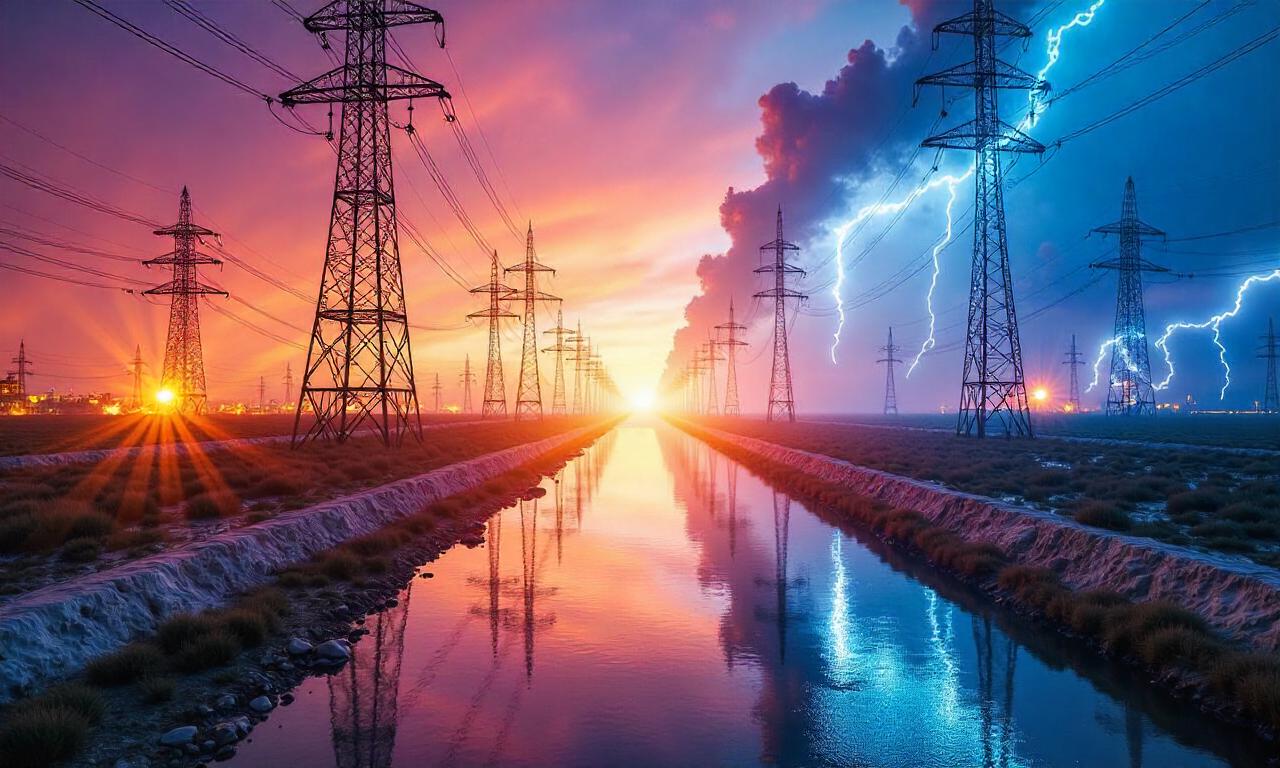
In today’s rapidly evolving world, the debate between renewable vs non-renewable energy has become more critical than ever. As concerns about climate change, environmental sustainability, and energy security grow, understanding the differences between these two energy sources is essential for making informed decisions. While both types of energy power modern life, their origins, environmental impacts, and long-term viability vary significantly. This article explores the renewable vs non-renewable energy comparison in depth, examining their pros and cons, applications, and how they fit into the global energy landscape. Whether you’re a student, a business leader, or a policy maker, this guide will help clarify which energy type is better for a sustainable future.
Table of Contents
ToggleThe Basics of Renewable and Non-Renewable Energy
To begin the renewable vs non-renewable energy comparison, it’s important to define both categories and understand their fundamental characteristics. Renewable energy comes from natural sources that are continuously replenished, such as sunlight, wind, rain, and geothermal heat. These sources are sustainable because they are not depleted when used. On the other hand, non-renewable energy is derived from finite resources that take millions of years to form, such as coal, oil, natural gas, and nuclear fuel.
Definition and Sources
Renewable energy refers to energy that is replenished naturally in a short period of time, making it a sustainable resource. Common sources include solar power, wind energy, hydropower, biomass, and geothermal energy. For instance, solar energy harnesses sunlight through photovoltaic panels or solar thermal systems, while wind energy utilizes turbines to convert wind into electricity. These sources are not only abundant but also eco-friendly, as they produce little to no greenhouse gas emissions during operation. Non-renewable energy, in contrast, relies on fossil fuels and nuclear reactions. Coal, oil, and natural gas are the most widely used non-renewable resources, primarily due to their high energy content and ease of extraction. Nuclear energy is another form of non-renewable energy, generated by splitting atoms in a process called fission. These sources are finite, meaning they will eventually run out, and their extraction and use often lead to significant environmental degradation.
Environmental Impact
The environmental impact of renewable vs non-renewable energy is a key factor in determining their sustainability. Renewable energy sources are generally considered cleaner and more environmentally friendly. For example, solar energy and wind energy do not emit pollutants during operation, reducing air pollution and mitigating climate change. However, their production and installation can have some environmental effects, such as land use changes or the impact of manufacturing solar panels and wind turbines. Non-renewable energy sources, on the other hand, have a much larger environmental footprint. The burning of coal, oil, and natural gas releases large amounts of carbon dioxide, sulfur dioxide, and other harmful emissions into the atmosphere. These emissions contribute to global warming, acid rain, and smog. Additionally, extracting these resources often involves deforestation, oil spills, and water contamination, further harming ecosystems. Nuclear energy is cleaner in terms of emissions but poses risks like radioactive waste and potential nuclear accidents.
The Pros and Cons of Renewable Energy
Advantages of Renewable Energy
One of the most significant advantages of renewable energy is its sustainability. Unlike non-renewable energy, which is limited in supply, renewable sources can be replenished naturally. This means they can provide energy for generations without depleting the Earth’s resources. Additionally, renewable energy is cleaner, reducing reliance on fossil fuels and decreasing the amount of greenhouse gases released into the atmosphere. For instance, wind energy is a zero-emission source, making it ideal for combating climate change.
Another benefit of renewable vs non-renewable energy is their versatility. Renewable energy can be harnessed in various forms, from solar power in sunny regions to hydropower in areas with abundant water resources. This adaptability allows countries to tailor their energy strategies to local conditions. Moreover, renewable energy systems often have lower operating costs once installed. While the initial investment for solar panels or wind turbines may be high, maintenance expenses are typically lower than those for fossil fuel plants.
Challenges of Renewable Energy
Despite their benefits, renewable energy also faces challenges. One of the primary limitations is intermittency. Solar energy and wind energy depend on weather conditions and may not be available 24/7. This can lead to energy shortages during periods of low sunlight or wind. To address this, energy storage solutions like batteries and hydrogen fuel cells are being developed, but they add to the cost and complexity of renewable systems.
Additionally, renewable energy infrastructure requires significant land and resource investment. Large solar farms or wind farms need space, which can sometimes conflict with agricultural or natural habitats. Geothermal energy and hydropower, while more consistent, may also have environmental trade-offs, such as altering natural water flow or disrupting geothermal ecosystems. Furthermore, the initial capital costs for renewable technologies can be a barrier for some regions, especially those with limited financial resources.
The Pros and Cons of Non-Renewable Energy
Advantages of Non-Renewable Energy
Non-renewable energy has several advantages that make it a popular choice for many countries. One of the main benefits is reliability. Fossil fuels like coal, oil, and natural gas can be stored and used on demand, making them ideal for baseload power generation. This is crucial for maintaining a stable energy supply, especially in regions where renewable sources may not be consistent.

Another advantage is energy density. Non-renewable energy sources contain a high amount of energy per unit volume, meaning they can generate significant power with relatively small quantities. This makes them efficient for industrial applications and large-scale energy production. Additionally, non-renewable energy infrastructure is often mature and well-established, with decades of experience in extraction, transportation, and utilization. This means that fossil fuel plants can be built and operated with a high degree of efficiency and cost-effectiveness.
Challenges of Non-Renewable Energy
The drawbacks of non-renewable energy are substantial. The most pressing issue is environmental degradation. The extraction of coal, oil, and natural gas leads to deforestation, soil erosion, and air and water pollution. For example, coal mining often involves strip mining, which can destroy entire ecosystems. Moreover, burning these fuels releases carbon dioxide and other pollutants, contributing to climate change and global warming.
Another challenge is resource depletion. Since non-renewable energy sources are finite, their overuse can lead to energy scarcity. As these resources become less available, energy prices may rise, affecting both individuals and industries. Additionally, nuclear energy while cleaner in terms of emissions, poses long-term waste management issues. Radioactive waste remains hazardous for thousands of years, requiring secure storage and disposal solutions.
The Future of Energy: Renewable vs Non-Renewable
The Role of Technology in Energy Transition
Technology is playing a pivotal role in the shift from non-renewable energy to renewable energy. Innovations in solar panel efficiency, wind turbine design, and battery storage are making renewable sources more viable. For instance, next-generation solar cells are now capable of capturing more sunlight, even in low-light conditions, while offshore wind farms are being developed to harness stronger and more consistent winds.
In the renewable vs non-renewable energy debate, smart grids and energy management systems are also emerging as critical tools. These systems help optimize the use of renewable energy by balancing supply and demand, reducing waste, and integrating different energy sources. Meanwhile, advancements in carbon capture and storage (CCS) technology are offering a way to mitigate the environmental impact of non-renewable energy by capturing emissions from fossil fuel plants. This hybrid approach allows for a transition period, giving countries time to invest in renewable infrastructure while still relying on non-renewable energy for immediate needs.
Economic and Social Implications
The economic implications of renewable vs non-renewable energy are significant. While renewable energy may require higher upfront costs, the long-term savings are substantial. Once installed, solar and wind systems have low operating costs and can reduce energy bills for households and businesses. Additionally, the renewable energy sector is creating green jobs, from manufacturing and installation to maintenance and research.
However, non-renewable energy still holds economic advantages in certain contexts. Fossil fuel industries are deeply entrenched in many economies, providing employment and energy security. Countries with abundant coal, oil, and natural gas reserves may rely on these resources for economic growth and export revenue. Moreover, the existing infrastructure for non-renewable energy, such as power plants and transportation networks, means that transitioning to renewables requires investment and time.
Global Energy Trends and Policies
Globally, the trend is increasingly favoring renewable energy. Many countries have set ambitious targets to reduce carbon emissions and increase the share of renewables in their energy mix. For example, the European Union aims to achieve carbon neutrality by 2050, with a significant focus on wind and solar energy. Similarly, China has invested heavily in hydropower and solar farms, positioning itself as a leader in renewable energy adoption.
On the other hand, non-renewable energy is still dominant in some regions due to infrastructure, cost, and availability. Developing countries often rely on coal and natural gas for affordable electricity and industrial growth, while developed nations are pushing for diversification. The renewable vs non-renewable energy debate is also influenced by international policies and climate agreements, such as the Paris Agreement, which encourages decarbonization and sustainable energy practices.
Conclusion
The renewable vs non-renewable energy comparison highlights the strengths and weaknesses of each energy type. Renewable energy offers a sustainable, clean, and versatile solution for the future, but it faces challenges like intermittency and high initial costs. Non-renewable energy, while reliable and energy-dense, has significant environmental drawbacks and is finite in supply.
Ultimately, the choice between renewable vs non-renewable energy depends on a variety of factors, including geographical location, economic conditions, and technological readiness. However, the long-term benefits of renewable energy—such as climate resilience, energy independence, and healthier ecosystems—make it a more sustainable option. As technology advances and policies evolve, the global energy landscape is shifting toward a greener future, with renewable energy playing a central role. The transition from non-renewable to renewable energy is not just an environmental necessity but also an economic opportunity. By investing in renewable energy, societies can reduce carbon emissions, create new jobs, and ensure energy security for future generations.
The renewable vs non-renewable energy debate is ongoing, but one thing is clear: the future of energy lies in sustainability. While non-renewable energy will continue to be a part of the global energy mix, renewable energy is the key to long-term environmental and economic stability. As the world moves toward a low-carbon economy, the adoption of renewable energy will be critical in achieving global climate goals and ensuring a cleaner, healthier planet for future generations.















